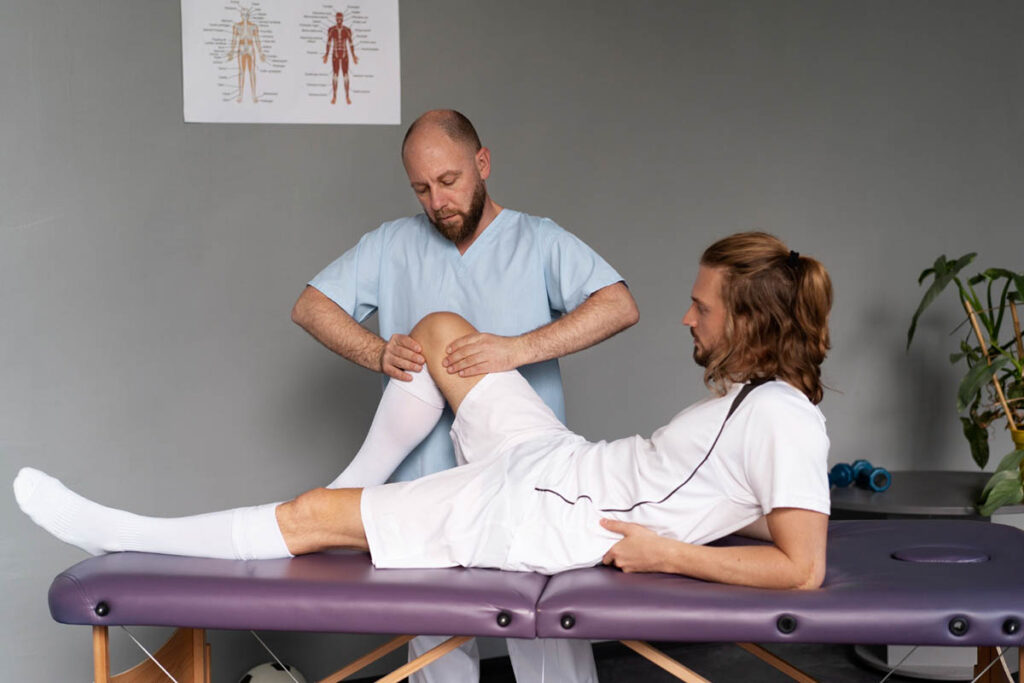A torn meniscus is a common knee injury, especially among athletes and active individuals. This type of injury can significantly impact your mobility, making even simple daily activities challenging. Timely treatment is crucial to prevent the condition from worsening. Physical therapy treatment often plays a pivotal role in the recovery process, offering effective, non-invasive methods to restore knee function and reduce pain.
If you’re dealing with a torn meniscus, you might wonder whether surgery is necessary or if physical therapy can help. This article explores everything you need about physical therapy to recover from a torn meniscus, the techniques involved, and exercises you can try.
What is a Torn Meniscus?
The meniscus is a crescent-shaped cartilage in your knee that acts as a shock absorber and stabilizer. Each knee has two menisci—medial (inner) and lateral (outer). The prevalence of meniscal tears is approximately 12% to 14%, with an approximate incidence of 61 cases in every 100,000 people. A torn meniscus occurs when this cartilage is damaged, often due to sudden twisting motions or repetitive stress.
Symptoms include pain, swelling, stiffness, and difficulty moving the knee. Left untreated, a torn meniscus can lead to long-term issues such as chronic knee pain or arthritis.
Can a Torn Meniscus Heal Without Surgery?
Can physical therapy help a torn meniscus? Depending on the type and severity of the tear, many meniscus tears can heal without surgery. Small, stable tears on the meniscus’s outer edge (where blood flow is higher) often respond well to conservative treatments like rest, physical therapy, and strengthening exercises.
Research shows that exercise-based physical therapy programs can yield significant improvements. The patients found the program relevant and effective, with only a few short-lasting adverse events and critical clinical improvements after four to ten weeks. Physical therapist supervision was considered important. No patients wanted surgery up to six months after the exercise therapy program. This highlights the effectiveness of non-surgical interventions under the supervision of a qualified physical therapist.
Do You Need Physical Therapy for a Torn Meniscus?
Yes, physical therapy for a torn meniscus is highly recommended for most cases. It helps reduce pain, restore range of motion, and strengthen the muscles supporting the knee. Whether you’re managing a minor tear or recovering post-surgery, physical therapy provides a tailored approach to recovery.
Benefits of Physical Therapy for Torn Meniscus
Physical therapy for a torn meniscus is a cornerstone of effective recovery. It addresses pain, strength, and mobility. Utilizing targeted techniques helps improve knee function while reducing the risk of future injuries.
- Pain relief: Techniques such as ice and manual therapy reduce inflammation and alleviate discomfort. These methods target the source of pain, providing immediate and lasting relief.
- Improved mobility: Strengthening exercises and stretches help restore the knee’s range of motion, making everyday movements easier. Consistent physical therapy prevents stiffness and promotes flexibility.
- Prevention of further injury: A customized exercise program strengthens the surrounding muscles, enhancing knee stability. This added support reduces the risk of re-injury during recovery.
- Faster recovery: Combining physical therapy techniques accelerates healing by simultaneously addressing pain, strength, and mobility. This holistic approach allows you to return to normal activities sooner rather than relying on rest alone.
Physical Therapy Techniques for Torn Meniscus

Physical therapists employ various techniques to promote healing and restore knee function in cases of a torn meniscus. These methods are tailored to reduce pain, improve mobility, and strengthen the surrounding muscles.
Stretching and Strengthening Exercises
Gentle stretching improves flexibility and reduces stiffness, helping to restore the knee’s natural range of motion. Strengthening exercises build muscle support around the knee joint, enhancing stability and preventing further injury.
Manual Therapy
Hands-on techniques alleviate joint stiffness and improve mobility by targeting specific areas of tension. These approaches also enhance blood flow, promoting faster healing and reducing discomfort.
Ice Therapy
Ice packs effectively reduce inflammation and swelling in the acute phase of a meniscus tear. Regular application helps numb the area, providing quick pain relief and minimizing further irritation.
Neuromuscular Electrical Stimulation (NMES)
NMES uses electrical impulses to trigger muscle contractions, aiding in weakened muscle recovery. This technique improves muscle strength and coordination and supports the knee during movement.
7 Exercises for a Torn Meniscus
Physical therapy exercises for torn meniscus play a crucial role in strengthening the muscles around the knee and improving joint stability after a meniscus tear. These low-impact movements promote healing, enhance mobility, and reduce the risk of future injuries.
1. Mini Squats
Perform shallow, controlled squats to strengthen the quadriceps without putting excessive pressure on the knee. This exercise improves stability and enhances knee function while being gentle on the joint.
2. Quadriceps Setting
Engage the quadriceps by tightening the thigh muscles while keeping the leg straight and holding the contraction for a few seconds. This is an effective way to activate the muscles without moving the knee joint, reducing strain.
3. Straight Leg Raise
Lie on your back and lift one leg straight into the air while keeping the other leg bent for support. This movement strengthens the quadriceps and improves core stability, supporting knee recovery.
4. Hamstring Curls
Curling your heel towards your glutes, either while standing or lying down, strengthens the hamstrings. This exercise builds muscle support behind the knee, improving joint stability and reducing stress.
5. Hamstring Heel Slide
While lying on your back, slowly slide your heel towards your buttocks to enhance mobility and reduce stiffness. This simple movement promotes better coordination between the hamstrings and the knee joint.
6. Standing Heel Raises
Stand on both feet and lift your heels off the ground, focusing on engaging your calves. This exercise strengthens the lower leg muscles, which provide additional stability to the knee joint.
7. Clams
Lie on your side with your knees bent, slowly lifting the top knee while keeping your feet together. This movement targets the hip abductors and improves overall lower body stability, benefiting knee alignment and function.
Exercises to Avoid
Specific exercises can worsen a torn meniscus by putting excessive strain on the knee joint. Deep squats place significant pressure on the cartilage, potentially aggravating the injury. High-impact activities like running or jumping can increase inflammation and delay healing. Additionally, pivoting or twisting movements stress the knee’s rotational stability, increasing the risk of further damage. It’s essential to avoid these activities during recovery and focus on low-impact exercises recommended by a physical therapist.
How Long Does Physical Therapy Take for a Torn Meniscus?

The duration of physical therapy varies depending on the severity of the tear and individual factors like age and activity level. Most people experience significant improvements within four to ten weeks. Consistency is key—adhering to your physical therapist’s recommendations ensures the best outcomes.
When to Seek Surgery Instead of Physical Therapy
While physical therapy is effective for many meniscal tears, surgery may be necessary if:
- The tear is large or complex.
- Symptoms persist despite conservative treatment.
- The knee locks or gives way frequently.
In such cases, arthroscopic surgery might be recommended, often followed by physical therapy for post-operative recovery.
How to Choose the Right Physical Therapist
Selecting the right physical therapist is crucial for a successful recovery. Look for professionals with:
- Experience in treating knee injuries.
- Positive patient reviews and recommendations.
- Customized treatment plans tailored to your specific needs.
At Vitality Therapy & Performance, we understand the unique challenges of recovering from a torn meniscus, especially for active individuals like runners. Our specialists are highly experienced in addressing rehab runners’ injuries and creating personalized treatment plans to restore knee function, reduce pain, and prevent future injuries. By incorporating cutting-edge physical therapy techniques, we help you get back to the activities you love safely and efficiently.
We also emphasize a holistic approach to recovery, ensuring that your treatment plan is tailored to your specific needs and goals. Whether you’re dealing with a minor tear or recovering from surgery, our team provides expert guidance and support every step of the way. With a combination of targeted physical therapy exercises for torn meniscus and evidence-based interventions, we’re here to help you regain your strength, mobility, and confidence.
Conclusion
A torn meniscus doesn’t always require surgery. With the right physical therapy program, you can alleviate pain, restore knee function, and return to your favorite activities. Techniques such as stretching exercises, manual therapy, and neuromuscular electrical stimulation speed up recovery. Additionally, research supports the success of physical therapy for meniscal tears, with significant improvements observed in just a few weeks. If you’re dealing with knee pain or suspect a meniscus tear, consult with a qualified physical therapist to develop a personalized treatment plan.
FAQs
Can a meniscus tear heal with physical therapy?
Yes, many meniscus tears can heal with physical therapy, especially minor tears in areas with adequate blood supply. A personalized exercise program guided by a physical therapist can enhance healing and effectively restore knee function.
What exercise is best for a torn meniscus?
Strengthening exercises like mini squats, straight leg raises, and clams are highly effective for promoting recovery and improving knee stability. These low-impact movements support the surrounding muscles without putting excessive strain on the joint.
What worsens a meniscus tear?
High-impact activities such as running or jumping, deep squats, and twisting motions can worsen a meniscus tear. These movements place undue stress on the knee joint, potentially increasing pain and delaying healing.

